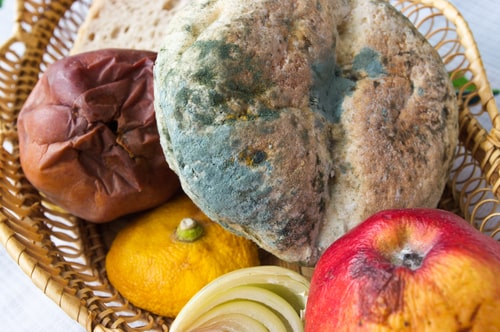How to Keep Food Fresh Longer and Prevent Mould in the Monsoon
We think of the refrigerator as a safe space where food is protected from mould and insects. However, the nooks and corners of refrigerators are spaces where food particles remain trapped, leading to fungus formation.

In the rainy season, mould is everywhere. Especially if you live in a coastal region or a place that receives incessant rainfall during the monsoon months. Food spoilage is accelerated during the monsoon as the air is more humid than usual. Spices and snacks left outside become soggy and lose their flavour and fragrance. Mould and fungus grow on damp food and on food that has been stored for too long or has been exposed to air and moisture. There are many different kinds of fungus that can grow on food.
You might have noticed a grey fur on old dishes, green fuzzy spots on stale bread, a white dust-like growth or black spots on fruits and cheese. Fungus formation on food makes it unsuitable for human consumption, often triggering allergies and respiratory problems. If the fungus is the kind that produces mycotoxins, the food can even be poisonous. When you notice fungus growth, it is best to dispose of the food immediately rather than removing the mouldy portion and decontaminating the food. Mould roots can extend to large parts of the food item, and they are often invisible to the human eye.
When food starts to rot, it begins to smell bad and attracts insects that can severely impact the hygiene of your home. It is thus, essential to take steps to prevent food spoilage.
Regularly clean your refrigerator
We think of the refrigerator as a safe space where food is protected from mould and insects. However, the nooks and corners of refrigerators are spaces where food particles remain trapped, leading to fungus formation. Clean the inside of the fridge regularly to prevent mould from taking root. Begin by removing all the shelves, racks and other removable parts. Then clean with a solution of warm water, vinegar and baking soda. Finish by wiping down with a dry cloth and air dry completely before replacing them. Place a small dish with baking soda in a corner of the fridge to absorb odours and excess moisture.
Avoid storing food outside
Fungus grows on food that is exposed to heat, moisture and air. So it is best to avoid storing food unattended. Although food stored outside might not immediately attract fungus, it will lose flavour and begin to discolour when exposed to the elements. Either store the food in airtight containers or inside the refrigerator.
Get the temperature right
Food spoils faster in warm, humid environments. It is thus important to set your refrigerator at a low temperature to prevent mould formation. Similarly, ventilate your kitchen by opening windows and doors to decrease humidity and install an exhaust fan to get rid of cooking steam. Avoid letting water stand in utensils and mop up spilt liquids immediately.
Go back to grandma’s remedies
In the absence of plastic storage containers and refrigerators, homemakers of the past were forced to use innovative techniques to prevent food loss due to spoilage. Thus were born some methods of food preservation that continue to be useful to this day. Prevent salt and sugar from clumping by adding a few grains of raw rice into the jars to absorb the excess moisture. Dry spices, food grains, flours and chillies in the sun before the rains set in. Solarisation reduces the moisture content of food and is useful to preserve any food which cannot be used up immediately. Traditionally, herbs were also used to keep mould and insects away. Dried neem leaves, bay leaves, turmeric, garlic cloves and dried chillies were stored along with sun-dried pulses and grains. Due to their natural anti-fungal properties, they help prolong the shelf life of food grains.
Store food in airtight containers
Sugar and salt are especially prone to lose their consistency during the monsoon. Store them in glass or stainless steel jars and keep them away from moist, hot places. Similarly, keep snacks and biscuits crisp and fresh by wrapping them in brown paper and storing them in an airtight container. Storing these foods in the refrigerator also helps them stay fresh for longer. Be sure not to store vegetables in the fridge when they are wet. Wash and air dry them before wrapping them in newspaper and storing them.
Befriend your freezer
For long-term food storage, the freezer is the best option since the temperature here is too cold for mould to tolerate. Freezing also kills insect eggs and mould spores present in flour, grain and pulses, so it is a good idea to store these items in the freezer for a day or two as soon as you buy them.
Dry that spoon
The slightest contact with moisture is enough for fungus to take hold in spice powders, flours and food grains and spoil their flavour and taste. Store these foods away from damp places and be careful not to introduce moisture into them.
This story made me
-
97
-
121
-
89
-
167
Tell Us More
If you found our story insightful, informative, or even just enjoyable, we invite you to consider making a voluntary payment to support the work we do at The Better India. Your contribution helps us continue producing quality content that educates, inspires, and drives positive change.
Choose one of the payment options below for your contribution-
By paying for the stories you value, you directly contribute to sustaining our efforts focused on making a difference in the world. Together, let's ensure that impactful stories continue to be told and shared, enriching lives and communities alike.
Thank you for your support. Here are some frequently asked questions you might find helpful to know why you are contributing?



















